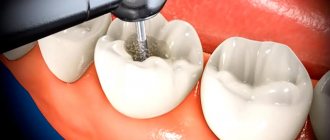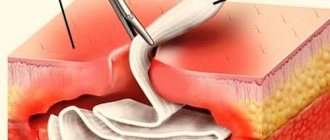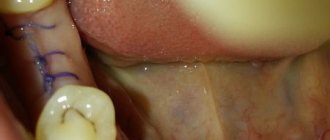A gum graft is a type of dental surgery performed to correct the effects of gum recession. This is a quick and relatively simple operation in which the doctor removes healthy gum tissue from the roof of the mouth and uses it to restore gum where it has receded.
Gum recession occurs when the gum tissue wears away, exposing more of the tooth at the root. This may cause increased sensitivity, especially when eating or drinking hot or cold foods. Because gum recession tends to happen slowly, many people don't realize it's happening to them.
If left untreated, gum recession can eventually lead to tooth loss.
Some people choose to have a gum graft for cosmetic reasons, such as having a better smile; while for others, a gum graft is needed to protect the damaged tooth from damage and repair the damage already done.
Content:
- Why does a wound take a long time to heal after tooth extraction?
- How gums heal normally
- Gum healing time
- How to speed up gum healing after tooth extraction
- What complications can tooth extraction cause?
Healing after tooth extraction can proceed quickly or take a long time. The second option is extremely undesirable and dangerous to the patient’s health. Therefore, it is important for the patient to know how long the regeneration process takes, what symptoms indicate a secondary infection, and how recovery can be accelerated.
What to consider when deciding on a transplant?
A person deciding whether to undergo gum transplant surgery should consider the following:
- Alternative Treatments : This may include tooth extraction if gum recession is already severe.
- Cost of surgery : If a person is considering surgery for cosmetic reasons only, they will likely have to cover the cost of the surgery out of pocket.
- Risks associated with untreated : Untreated gum recession can lead to severe gum disease and possible tooth loss. Gum disease can also cause additional problems such as heart disease and diabetes.
By maintaining good oral hygiene and visiting your dentist regularly for regular checkups, you can reduce your risk of developing gum disease and catch it early if it begins to develop.
Why does a wound take a long time to heal after tooth extraction?
Ripping out a destroyed unit is a very traumatic process. This operation is comparable to any other surgical procedure. The tissue surrounding the removed roots is severely damaged. The integrity of the periodontal and periodontal zones is compromised.
Microtears of ligaments and destruction of individual nerve bundles are observed. The injured area swells, turns blue, swells, and becomes painful to the touch. It is clear that in such a situation regeneration cannot be lightning fast. It should be understood that how long it takes for gums to recover depends on many factors:
- person's age;
- an illness that necessitated dental surgery;
- characteristics of the patient's health status;
- the presence of concomitant pathologies of a systemic nature in the patient;
- the complexity of the surgical procedures being performed;
- experience of a dental surgeon;
- the need for sutures;
- the number of roots in the tooth being pulled out;
- features of the location of the unit in the dentition.
How gums heal normally
Very often, patients ask the doctor how long it takes for the gums to heal after tooth extraction. They want to know how quickly they can return to their normal lifestyle. The rehabilitation process is quite long. It proceeds through several successive stages:
- Stop bleeding. Takes up to three hours. As soon as the blood stops flowing, a scarlet clot forms. It prevents bacteria, viruses and microbes from penetrating deep tissues.
- The appearance of a white connective film. This is epithelial tissue. It can be seen four days after removal.
- The clot acquires a white color. Occurs approximately one week after surgery.
- Replacement of a blood clot with full-fledged epithelial tissue. It is fixed approximately 20-24 days after tooth extraction. This indicates that regeneration was successful.
As a rule, less than a month after tooth extraction, the patient is completely healthy, feels well and does not experience any discomfort while eating. If the number of roots pulled out was small, then regeneration can be completed in two to three weeks.
Procedure
A dentist discusses gum transplant surgery with a patient.
There are different types of gum grafts available.
There are a variety of gum grafts, and the type of surgery depends on the extent and severity of the damage and the individual's individual needs.
The periodontist will discuss the different types of surgery available with the person to decide which option is most suitable.
Before the gum graft begins, the periodontist will administer a local anesthetic to numb the area so that the procedure is not affected.
They may also remove some of the existing gum to expose the root of the tooth and clean it.
Three different types of gum transplant surgery:
In this procedure, the periodontist:
- removes tissue from the roof of the mouth by making a flap and taking tissue from underneath the top layer
- sews tissue onto existing gum tissue to cover the exposed tooth
- seams flap on the roof of the mouth where they got the fabric from
Free gum vaccinations
This is the preferred method for people with thin gums who require additional tissue to enlarge their gums.
In this procedure, the periodontist:
- removes tissue directly from the top layer of tissue on the roof of the mouth
- stitches this tissue down to the existing gum area
Pedicle (lateral) grafts
This is the preferred method for people who have a lot of gum tissue growing near an exposed tooth.
In this procedure, the periodontist:
- gum graft tissue around or adjacent to the tooth in need of treatment
- only partially cuts off this tissue, supporting one edge
- stretches the tissue over or down to cover the exposed tooth root and hold it in place with stitches
The periodontist can remove tissue from a tissue bank rather than removing rubbery tissue from a person's mouth.
Preparing for gum transplant surgery
Someone must drive the person home after the procedure.
Once you and your dentist have considered all the options and decided on the type of surgery, it is important to ensure that a family member or friend accompanies you.
This is important because pain medications are not safe during gum graft surgery.
People who receive gum vaccinations will be able to return home after the procedure. The doctor will provide all post-operative care instructions to ensure successful healing of the graft.
Recovery
Recovery will help:
- avoid brushing teeth at the treatment site
- use a special mouthwash to reduce plaque buildup
- take antibiotics to reduce the risk of infection
- avoid strenuous exercise
- avoid foods that are difficult to eat
- eating soft, cool foods such as ice cream, pasta, eggs, yogurt, and soft cheese
- avoid smoking
The pain and discomfort a person experiences will vary. For example, if the periodontist uses tissue from a tissue bank, the person will experience minimal pain. If tissue from the roof of the mouth is removed, a person may feel pain for several days.
The healing process is often quick, with 1 to 2 weeks for the mouth to completely heal, but can sometimes take longer. People can take over-the-counter pain relievers or prescription medications to help manage any discomfort.
After the procedure, teeth may become more sensitive than usual, especially to hot and cold foods, and people may benefit from using a desensitizing toothpaste or mouthwash.
Most can return to work the next day.
There will likely be a follow-up appointment with your dentist after surgery to check that the healing process is going well as expected. The dentist may also remove sutures if necessary.
Not only will your gums look different after surgery, but they may become stiffer and harder.
Gum healing time
Conventionally, dentists divide the regeneration process into two stages - partial, complete. Partial epithelization is said to occur in the first 12 days after tearing out, and complete epithelialization occurs after 20-25 days. But with complex removal, leading to significant damage to bone tissue and muscles, the recovery period may increase by several more days.
Among the most common reasons causing slow epithelization:
- significant trauma to bone tissue and gums during the intervention (especially if the bone around the diseased tooth was cut out with a drill);
- the occurrence of alveolitis of the inflamed socket;
- damage to the protective clot or its unformation (“dry” hole);
- incomplete removal of bone fragments due to the doctor’s carelessness;
- mobility of the mucous membranes, which needed to be sutured, but for some reason the surgeon decided not to suture;
- refusal to use antibiotics during a severe recovery period;
- diabetes;
- reduced immunity.
How to speed up gum healing after tooth extraction
The simplest and most effective technique that a dental surgeon can use to ensure fast and effective regeneration is suturing the socket. It is important to ensure that the edges of the mucous membranes are located as close to each other as possible. This will reduce the risk of secondary infection and create suitable conditions for trouble-free regeneration.
It is also very important that the patient strictly followed all medical prescriptions. The pharmacy offers a wide range of healing and anti-inflammatory ointments, gels, creams and solutions used in dentistry. But you don’t need to buy the first product that comes your way—the drug must be prescribed by a doctor.
It is very important not to touch the healing hole with your tongue or foreign objects. It is forbidden to touch the blood clot covering the wound. If you move it from its place, severe inflammation may occur. Then it will most likely not be possible to do without antibiotics.
How to rinse your mouth after a gum incision
Rinsing the mouth after surgery is not done immediately, so as not to wash out the blood clot from the wound.
They use pharmaceutical products: chemical and herbal, as well as those prepared at home.
| Ready-made products | Home Remedies | |
| Chemical | On herbs | |
| Chlorhexidine | Stomatophyte | Infusions: · sage; · chamomile; · oak bark; · calendula; take 1 tbsp. for 1 tbsp. boiling water, leave for 15–30 minutes, strain, cool, add to a volume of 200 ml |
| Miramistin | Maraslavin | Saline or soda-salt solution (1 teaspoon each of soda and salt, preferably sea salt, per 1 cup of water) |
| Furacillin | Rotokan | Light pink solution of potassium permanganate |
Soda and salt solution
In addition to general recommendations, the doctor will advise what to rinse the mouth of a particular patient.
You need to rinse after each meal until swelling and pain disappear. Sometimes the same products are used for applications and lotions on the incision area.
What complications can tooth extraction lead to?
Normally, restoration of injured tissue occurs within three weeks. The red, inflamed gum gradually acquires a pale pink color and ceases to be painful on palpation. But if a person has diseases that prevent rapid recovery, or he does not comply with doctor’s orders, then the rehabilitation process can be difficult. Then the patient will face complications, including:
- hematoma;
- severe swelling of the soft tissues of the cheek;
- frequent bleeding from the wound;
- numbness of the tongue, cheeks, lips;
- pain while eating.
If the healing of the hole is in doubt - a person thinks that something is going wrong - he should immediately consult a doctor. The doctor will conduct an examination and tell you whether you need to use any drugs to speed up regeneration.
Complications after surgery
Complications of gum incisions include:
- fever, indicating current inflammation;
- swelling of the gums;
- boring, burning pain radiating to the jaw bone, ear;
- bleeding 1–2 hours after surgery;
- flux.
Self-medication here is dangerous, since any of the complications may require repeated incision of the gums.
Edema and swelling
Swelling at the wound site for 2–3 days is acceptable. If it spreads to the cheek, this may be a sign of alveolitis - inflammation of the socket, requiring repeated intervention.
Heat
With normal healing, the temperature gradually drops by day 4–5. If it lasts longer and becomes higher, the wound has become infected and a new operation is needed.
Pain
The pain gradually subsides. When it increases, the appearance of a new character, severity, coupled with swelling and high temperature, surgical treatment of a purulent infection is required.
Bleeding
When the gums are cut, bleeding occurs after 1–2 hours. Homemade hemostatic agents are used: hydrogen peroxide, applying a tampon to the wound. If the patient sees that the bleeding does not stop, urgent assistance from a dentist is needed.
Flux
With increased pain and swelling, inflammation can spread to the periosteum of the jaw, and gumboil occurs. Surgical treatment is needed.










